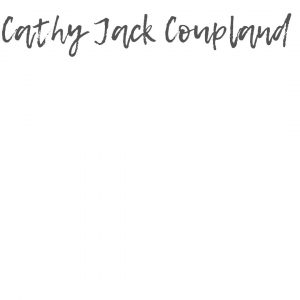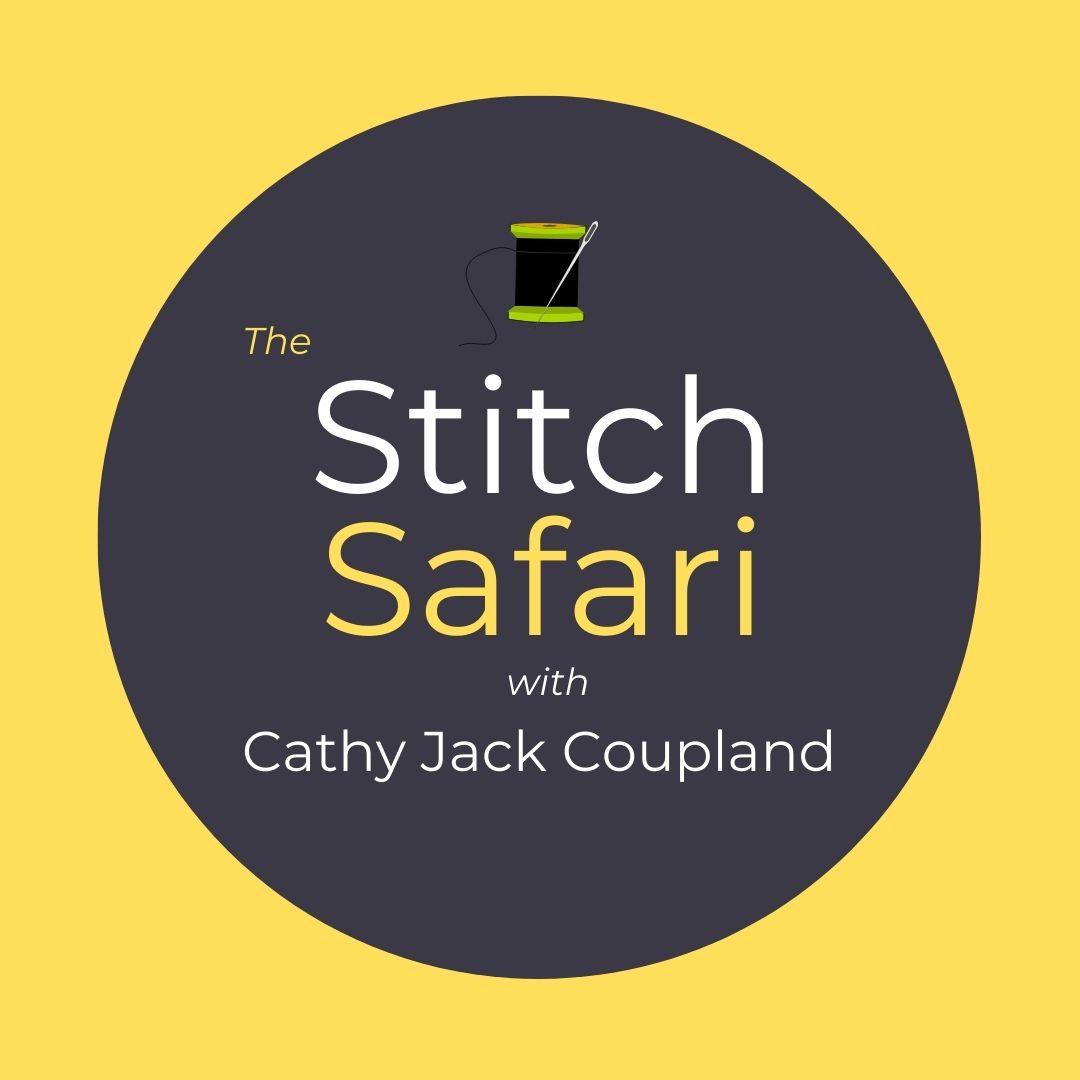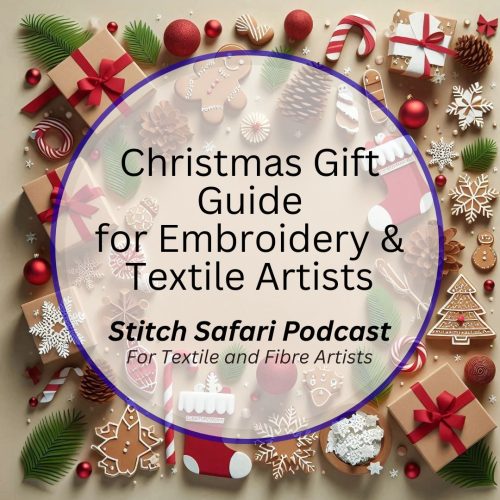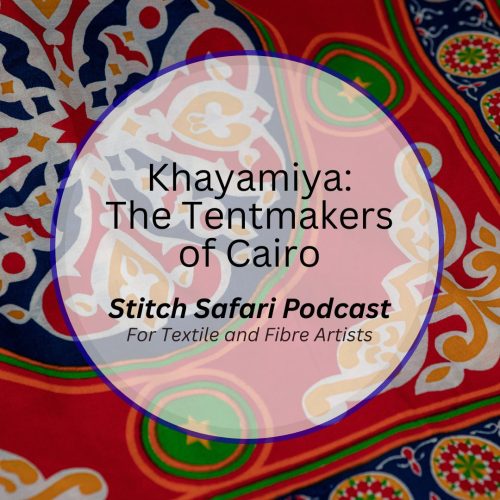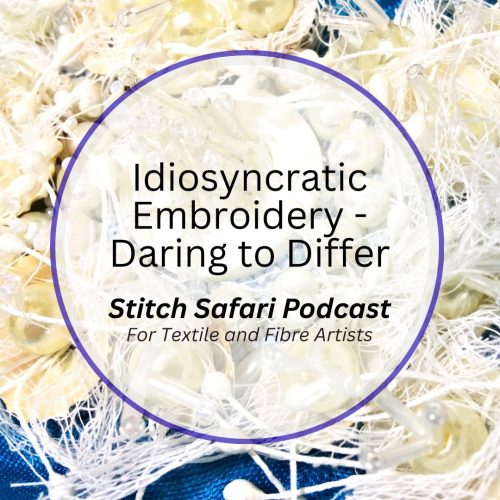There’s a reason why embroidery is associated with connection – it can be a driving force full of potency, energy and poignancy.
Link a worldwide group of collaborative embroiderers to see the true power of stitch – and that’s exactly what this episode of Stitch Safari is about – highlighting three collaborative embroidery projects driven by women for women.
Three themes with very different rationales, all drawing upon embroidery as a vehicle to raise awareness, promote connection and offer a voice of self-expression.
What a fantastic way to show the commonality of a simple needle and thread.
Let’s jump straight in to explore these divergent yet fascinating collaborative embroidery events and begin with The Red Dress Project – now this is truly amazing and the end product is cohesive and eye-catching.
Conceived by British artist Kirstie Macleod, the award-winning Red Dress Project spanned 14 years from 2009 to 2023 providing a platform for many vulnerable or poverty-stricken women worldwide to voice their stories through stitch.
But it also attracted those who wished to use the platform as a means of self-expression so their voices could be heard.
Just imagine pieces of embroidery travelling the globe continuously – and the finished dress attracting attention wherever it was shown – including Paris, Dubai, Mexico, Kosovo, Pittsburgh, Wales, London and Italy where it won first place in the Premio Valtellina Textiles Award.
Weighing in at 20 kilos and made from red silk, the dress is covered in millions of stitches – but is the weight in the fabric and stitch that holds the dress together or in the individual voices and collective stories those stitches are now enabled to tell?
Constructed from 87 pieces of burgundy silk dupion, the dress was worked on by 367 girls and women, 11 men and boys and 2 non-binary artists from 51 countries – 141 commissioned embroiderers were paid for their work and continue to receive a portion of all ongoing exhibition fees and merchandise. They also have the opportunity to sell their work through the Red Dress Etsy shop.
As a side note, research into the numbers for the embroiderers and the weight of the dress varied drastically.
Further embroidery was added by people from the audiences of the various exhibitions and events – that’s very immersive.
Some of the embroiderers were established professionals but pieces were also created by first-time artists who were encouraged to express their identities of cultural and traditional experiences.
The embroiderers included female refugees from Palestine, Syria and Ukraine, women seeking asylum in the UK from Iran, Iraq, China, Nigeria and Namibia along with survivors of war in Korea, Bosnia and Herzegovina, Rwanda and DR Congo; impoverished women in South Africa, Mexico and Egypt, individuals in Kenya, Japan, Turkey, Jamaica, Sweden, Peru, Czech Republic, Dubai, Afghanistan, Australia, Argentina, Germany, Switzerland, Canada, Tobago, Vietnam, Estonia, USA, Russia, Pakistan, Wales, Colombia and England including students from Montenegro, Brazil, Malta, Singapore, Eritrea, Norway, Poland, Finland, Ireland, Romania and Hong Kong. Assistance was also given from upmarket embroidery studios in India and Saudi Arabia.
Some charities provided logistical and practical support with an initial seed investment by the British Council Dubai in 2009 with further funding from organisations, individuals, crowdfunding campaigns and private donations.
The Red Dress continues to travel to galleries, museums and event spaces worldwide with a continued aim of being accessible to all.
Some of the styles of embroidery have been practised for hundreds of years in families and villages and some embroideries convey powerful events from their maker’s past while some have been made by women who are rebuilding their lives with the help of embroidery – learning and using a skill to earn a decent and consistent living.
Wow, if that doesn’t encapsulate the power of a needle and thread and its ability to link people together, then I don’t know what will.
One dress, richly embroidered generates a dialogue uniting people around the world through stitch.
Originally it was to be called Barocco – a Portuguese term for an imperfect pearl that Macleod felt indicated something special stuck inside a structure – however she changed it to The Red Dress as it was more easily understood and pronounced – and I think she was probably right.
And to finish, some quotes on The Red Dress Project from textile leaders:
Nothing expresses more eloquently the feelings I suspect we share about the importance of embroidery in our lives, and the support we derive from the friendships made through stitch, than Kirstie Macleod’s Red Dress. Caroline Zoob, Editor of Stitchers Journal, 2022.
The Red Dress has become an icon of the international textile world. Suzanne Smith, Textile Society 2022
It’s her (Kirstie’s) Red silk dupion bodice and voluminous skirt created for the red dress that fully demonstrates her commitment to embroidery and her immense respect for the international community of makers. Donna Jones, Embroidery Magazine 2010.
Now onto another amazing collaborative embroidery project titled 25 Million Stitches – a visionary project from Jennifer Kim Sohn where each stitch represents the 25 million estimated refugees worldwide – a simple yet powerful expression of the use of stitch to communicate a message.
The project represents the enormity of the approximate number of refugees estimated by the United Nations High Commissioner for Refugees when this project first began.
Walls of embroidered panels create walkways of storytelling – they’re exhibited as if the panels themselves create a decorated passage of meaning forming a highly resonant expression of art and activism raising awareness of the numbers of people forcibly displaced from their homelands by violence and natural disasters.
The project was launched in May 2019, collecting 25 million hand-sewn stitches in under one year.
People need to tell their stories and express their lives and their pain, but also to show support and care.
Graduate students, schools, kindergartens, generations of families, and groups of diverse faith organisations donated their time to express their support for the refugees.
One little girl wrote this note to accompany her stitching: ‘Dear 25 million stitches, the total of my stitches is 219. I sent this to you on my 7th birthday. Rosie. There’s a smiley face and a simple drawing of her stitching.
Then there’s an intricately worked, artistically designed panel beautifully stitched by Penny Peters from Washington depicting fleeing refugees.
Other panels depict rainbows, hearts and flowers, symbolism and script to showcase their thoughts – many are very simply stitched – some are colourful, some are not.
This project included over 2,300 embroiderers from 37 countries worldwide – ranging from 5 to 91 years of age.
These panels help people process the enormity of 25 million displaced souls – but it’s their collective presentation and narrative quality that evokes such pathos from both the stories behind each work and the scale of the exhibition, raising awareness of the global refugee crisis.
2200 panels have been sewn together to create a huge installation of work – it’s powerful and awe-inspiring providing corridors of stitched narratives.
So we’ve heard of two very different yet extremely powerful projects involving the worldwide use of embroidery to connect and depict.
Lastly, I’d like to deal with something completely different.
It comes from the amazing English contemporary embroidery artist, Louise Gardiner, who sadly passed away in 2023.
Louise just seemed to exude energy, fun and excitement and her work was thoughtful and unique.
The Project of Louise’s I’d like to focus on here is The Stitch a Cloud Project which produced work to create the Cape of Clouds along with a wonderful showpiece jacket Louise wore to many of her craft events and shows.
This idea began small and then mushroomed as all good ideas do.
Louise opened her studio to what she called ‘Superstitcher Nights’ inviting local people to come and stitch some small felt clouds with her.
The idea was an off-shoot of the spectacular Cape of Empowerment Louise designed and made commissioned by the Pukka herbal tea company – this cape though was to be of clouds.
Louise felt there was a need and an eagerness for women to communicate their hopes and dreams for a peaceful world promoting equality and love.
And what a beautiful and fitting tribute to English creative embroidery artist Louise Gardiner.
Wow, three very different collaborative worldwide embroidery projects – all offering a solace that only embroidery can bring, but in doing so, connecting people from myriad countries and backgrounds.
Embroidery speaks a universal language – one that’s understood everywhere.
These collaborative artworks are all incredibly poignant – highlighting connection, diversity and the power of embroidery – to voice opinions, show support, offer love and care or just for the sheer beauty of it – slowing us down to enjoy and relax precious moments of relief from our busy lives.
It’s the power of a simple needle and thread to connect and join.
And I think that’s amazing.
Louise wrote this: ‘My thoughts developed into clouds floating across the landscape, the weather changing and the sun shining in between’.
And so from six Superstitcher evenings, Louise decided to open the project up to the world – she desired to connect with other creatives asking them to represent femininity and creativity.
A casual call out for contributions resulted in numerous embroidered felt clouds appearing through her letterbox accompanied by heartfelt letters and photos, so much so that one day they blocked her door on return from shopping.
Clouds arrived from Venice, Belgium, Hong Kong, New Zealand, and Australia – over 15 months Louise received 325 clouds.
Each cloud and theme was unique – themes such as peace, love, friendship, nature, grief, happiness and beauty.
Louise notes that the project had a life of its own, raising awareness of slow time, contemplation and the time spent amongst friends, forming supportive ways to explore traditional techniques, reconnecting handwork with others and with ourselves – even if you couldn’t see your fellow stitches there was a connection via an invisible thread.
Louise felt there was a need and an eagerness for women to communicate their hopes and dreams for a peaceful world promoting equality and love.
And what a beautiful and fitting tribute to English creative embroidery artist Louise Gardiner.
Wow, three very different collaborative worldwide embroidery projects – all offering a solace that only embroidery can bring, but in doing so, connecting people from myriad countries and backgrounds.
Embroidery speaks a universal language – one that’s understood everywhere.
These collaborative artworks are all incredibly poignant – highlighting connection, diversity and the power of embroidery – to voice opinions, show support, offer love and care or just for the sheer beauty of it – slowing us down to enjoy and relax precious moments of relief from our busy lives.
It’s the power of a simple needle and thread to connect and join.
And I think that’s amazing.
